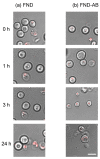Targeting Nanodiamonds to the Nucleus in Yeast Cells
- PMID: 33023102
- PMCID: PMC7601435
- DOI: 10.3390/nano10101962
Targeting Nanodiamonds to the Nucleus in Yeast Cells
Abstract
Nanodiamonds are widely used for drug delivery, labelling or nanoscale sensing. For all these applications it is highly beneficial to have control over the intracellular location of the particles. For the first time, we have achieved targeting the nucleus of yeast cells. In terms of particle uptake, these cells are challenging due to their rigid cell wall. Thus, we used a spheroplasting protocol to remove the cell wall prior to uptake. To achieve nuclear targeting we used nanodiamonds, which were attached to antibodies. When using non-targeted particles, only 20% end up at the nucleus. In comparison, by using diamonds linked to antibodies, 70% of the diamond particles reach the nucleus.
Keywords: fluorescence nanodiamonds; nucleus targeting; yeast cells.
Conflict of interest statement
The authors declare no conflict of interest.
Figures






Similar articles
-
The Fate of Lipid-Coated and Uncoated Fluorescent Nanodiamonds during Cell Division in Yeast.Nanomaterials (Basel). 2020 Mar 12;10(3):516. doi: 10.3390/nano10030516. Nanomaterials (Basel). 2020. PMID: 32178407 Free PMC article.
-
Nanodiamonds as multi-purpose labels for microscopy.Sci Rep. 2017 Apr 7;7(1):720. doi: 10.1038/s41598-017-00797-2. Sci Rep. 2017. PMID: 28389652 Free PMC article.
-
Nanodiamonds for In Vivo Applications.Small. 2018 May;14(19):e1703838. doi: 10.1002/smll.201703838. Epub 2018 Feb 9. Small. 2018. PMID: 29424097 Review.
-
The Response of HeLa Cells to Fluorescent NanoDiamond Uptake.Sensors (Basel). 2018 Jan 26;18(2):355. doi: 10.3390/s18020355. Sensors (Basel). 2018. PMID: 29373504 Free PMC article.
-
Nanodiamonds and Their Applications in Cells.Small. 2018 Jun;14(24):e1704263. doi: 10.1002/smll.201704263. Epub 2018 Mar 24. Small. 2018. PMID: 29573338 Review.
Cited by
-
Application of Nano-Crystalline Diamond in Tribology.Materials (Basel). 2023 Mar 28;16(7):2710. doi: 10.3390/ma16072710. Materials (Basel). 2023. PMID: 37049004 Free PMC article. Review.
-
Targeting cell surface glycans with lectin-coated fluorescent nanodiamonds.Nanoscale Adv. 2022 Feb 7;4(6):1551-1564. doi: 10.1039/d2na00036a. eCollection 2022 Mar 15. Nanoscale Adv. 2022. PMID: 36134370 Free PMC article.
-
A fluorescent-protein spin qubit.Nature. 2025 Sep;645(8079):73-79. doi: 10.1038/s41586-025-09417-w. Epub 2025 Aug 20. Nature. 2025. PMID: 40836095 Free PMC article.
-
Intracellular Thermal Probing Using Aggregated Fluorescent Nanodiamonds.Adv Sci (Weinh). 2022 Jan;9(3):e2103354. doi: 10.1002/advs.202103354. Epub 2021 Nov 23. Adv Sci (Weinh). 2022. PMID: 34813176 Free PMC article.
References
-
- Haziza S., Mohan N., Loe-Mie Y., Lepagnol-Bestel A.-M., Massou S., Adam M.-P., Le X.L., Viard J., Plancon C., Daudin R., et al. Fluorescent nanodiamond tracking reveals intraneuronal transport abnormalities induced by brain-disease-related genetic risk factors. Nat. Nanotechnol. 2016;12:322–328. doi: 10.1038/nnano.2016.260. - DOI - PubMed
Grants and funding
LinkOut - more resources
Full Text Sources
Molecular Biology Databases

